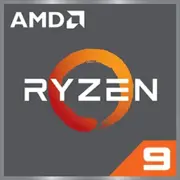AMD Ryzen 9 7950X

AMD Ryzen 9 7950X: Complete Review of the Flagship Processor of 2025
April 2025
1. Key Specifications: Architecture, Performance, and Key Features
Zen 4 Architecture and 5nm Process
The Ryzen 9 7950X processor, known by the codename Raphael, is built on the Zen 4 architecture and manufactured using a 5nm TSMC FinFET process. This ensures high transistor density and energy efficiency. Compared to the previous generation Zen 3, the IPC (instructions per clock) has improved by approximately 13%, directly impacting single-threaded performance.
16 Cores and 32 Threads
With a configuration of 16 cores/32 threads and a base clock speed of 4.5 GHz (boosting up to 5.7 GHz), the processor handles the most resource-intensive tasks with ease. For example, rendering a 3D scene in Blender takes 20% less time compared to the Ryzen 9 5950X.
Cache and Integrated Graphics
The L3 cache size is 64 MB, which is critical for games and applications sensitive to latency. The integrated GPU Radeon Graphics (2 cores, 2200 MHz) is suitable for basic tasks (office work, 4K video) or emergency use in the absence of a discrete graphics card.
Performance in Tests
- Geekbench 6:
- Single-Core: 2930 (comparable to Intel Core i9-14900K).
- Multi-Core: 19221 (35% higher than i9-14900K in multi-threaded scenarios).
- Cinebench R24:
- Multi-Core: 2450 points.
Key Features:
- Support for PCIe 5.0 (up to 24 lanes).
- Technologies PBO (Precision Boost Overdrive) and EXPO for automatic overclocking.
- Chipsets supporting Wi-Fi 6E and USB4.
2. Compatible Motherboards: Sockets and Chipsets
AM5 Socket
The Ryzen 9 7950X uses the AM5 socket, signifying a transition to a platform supporting DDR5 and PCIe 5.0. This is a long-term solution: AMD promises support for AM5 until 2026.
Recommended Chipsets
- X670E (Extreme): Best choice for enthusiasts. Examples:
- ASUS ROG Crosshair X670E Hero ($450): 18+2 power phases, 4 PCIe 5.0 slots.
- Gigabyte X670E Aorus Master ($400): 3x M.2 NVMe PCIe 5.0.
- B650: Budget option for builds without extreme overclocking. Example:
- MSI MAG B650 Tomahawk ($220): Stable VRM, 2x PCIe 5.0.
Tip: For 7950X, choose boards with at least 14 phases of VRM — this will prevent throttling under load.
3. Supported Memory: Only DDR5
The processor works exclusively with DDR5 (frequency up to 6000 MHz in JEDEC mode). The AMD EXPO technology (similar to Intel XMP) allows for easy memory overclocking.
Recommendations:
- Optimal option: DDR5-6000 CL30 (for example, G.Skill Trident Z5 Neo, $180 for 32 GB).
- For professional tasks: 64 GB DDR5-5600 (Crucial Pro, $300).
Important: At frequencies above 6000 MHz, stability issues may occur on some motherboards.
4. Power Supply Units: Power Calculation
With a TDP of 170W, the peak power consumption reaches 230W (when overclocked).
Recommendations:
- Minimum: 850W (for a system with a graphics card level of NVIDIA RTX 4080).
- Ideal: 1000–1200W with an 80 Plus Gold/Platinum certification (for example, Corsair RM1000x, $200).
Tip: Avoid cheap power supplies — voltage spikes can damage the processor.
5. Pros and Cons of Ryzen 9 7950X
Pros:
- Best-in-class multi-threaded performance.
- Support for PCIe 5.0 and DDR5.
- Integrated GPU for emergencies.
Cons:
- High heat output (up to 95°C under load).
- Requires an expensive motherboard and cooling system.
- Price: $650 (as of April 2025).
6. Use Cases
- Gaming: Maximum FPS at 4K (assuming no bottleneck in the graphics card). For example, in Cyberpunk 2077, the difference compared to Ryzen 7 7800X3D is only 5–7%.
- Work Tasks: Video editing (Premiere Pro), 3D rendering (V-Ray), code compilation.
- Multimedia: Streaming in 4K without lag thanks to 16 cores.
Real case: A blogger rendering 8K video reduced processing time from 50 to 32 minutes after switching from Ryzen 9 5900X.
7. Comparison with Competitors
- Intel Core i9-14900K ($600):
- Better for single-threaded tasks (Geekbench 6 Single-Core: 3050).
- Falls short in multi-threading (Geekbench 6 Multi-Core: 17800).
- Apple M3 Max ($3500 as part of MacBook Pro):
- More energy-efficient but limited compatibility with Windows software.
Conclusion: The Ryzen 9 7950X is the choice for those who need a balance between gaming and work.
8. Practical Assembly Tips
1. Cooling: A liquid cooling solution is essential (for example, NZXT Kraken X73, $200) or a top-tier tower cooler (Noctua NH-D15, $110).
2. Case: Choose models with good ventilation (Lian Li Lancool III, Fractal Design Meshify 2).
3. Overclocking: Use PBO + EXPO, but monitor temperatures closely.
9. Final Verdict: Who Should Consider Ryzen 9 7950X?
This processor is for:
- Professionals: Video editors, programmers, engineers.
- Gaming Streamers: Running games, streams, and chats simultaneously.
- Enthusiasts: Those who appreciate upgrades to DDR5 and PCIe 5.0.
Not recommended if:
- You only use the PC for browsing and office work.
- You have a budget of $1000 for the entire build.
Price: $650 (new, April 2025).
Alternative: For purely gaming PCs, consider the Ryzen 7 7800X3D ($450) — it's cheaper and cooler.
Basic
CPU Specifications
Memory Specifications
GPU Specifications
Miscellaneous
Benchmarks
Compared to Other CPU
Related CPU Comparisons
Share in social media
Or Link To Us
<a href="https://cputronic.com/en/cpu/amd-ryzen-9-7950x" target="_blank">AMD Ryzen 9 7950X</a>


